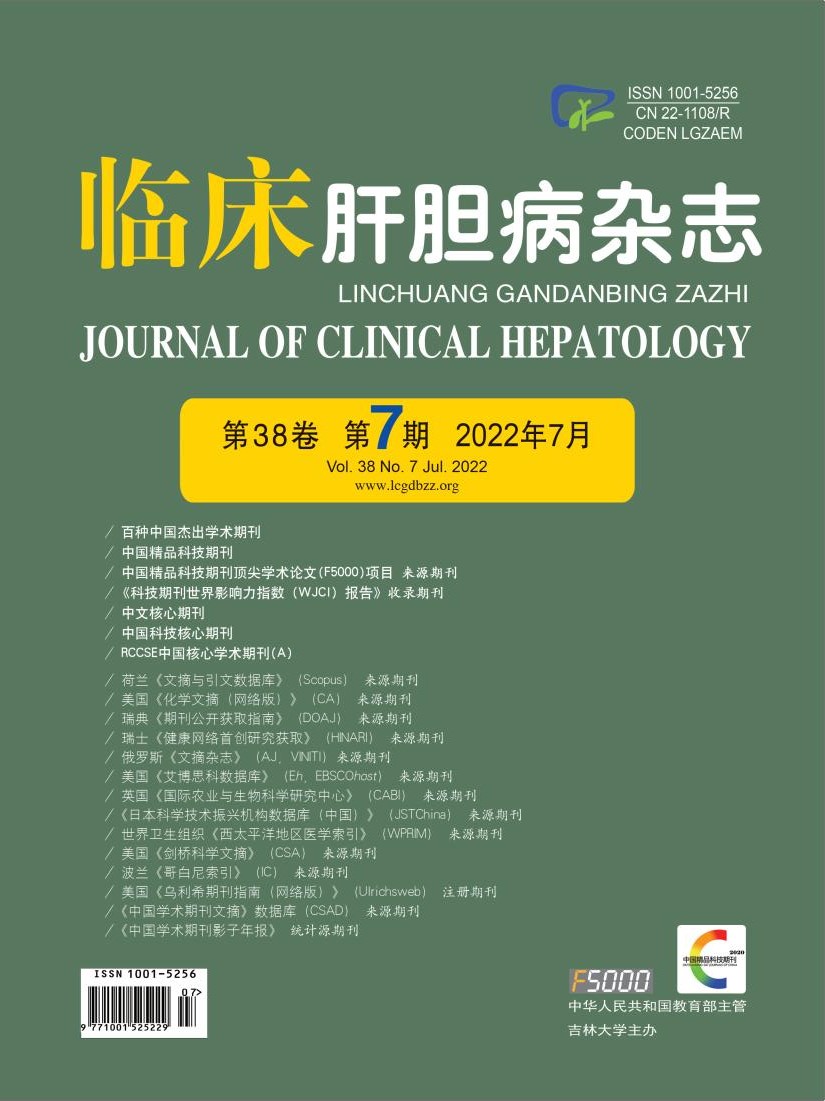| [1] |
MAROZAS M, ZYKUS R, SAKALAUSKAS A, et al. Noninvasive evaluation of portal hypertension using a supervised learning technique[J]. J Healthc Eng, 2017, 2017: 6183714. DOI: 10.1155/2017/6183714. |
| [2] |
MAHMOUD AE, ELIAS E, BEAUCHAMP N, et al. Prevalence of the factor V Leiden mutation in hepatic and portal vein thrombosis[J]. Gut, 1997, 40(6): 798-800. DOI: 10.1136/gut.40.6.798. |
| [3] |
PLESSIER A, VALLA DC. Budd-Chiari syndrome[J]. Semin Liver Dis, 2008, 28(3): 259-269. DOI: 10.1055/s-0028-1085094. |
| [4] |
BOLONDI L, GAIANI S, LI BASSI S, et al. Diagnosis of Budd-Chiari syndrome by pulsed Doppler ultrasound[J]. Gastroenterology, 1991, 100(5 Pt 1): 1324-1331.
|
| [5] |
SOYER P, RABENANDRASANA A, BARGE J, et al. MRI of Budd-Chiari syndrome[J]. Abdom Imaging, 1994, 19(4): 325-329. DOI: 10.1007/BF00198189. |
| [6] |
XU P, LYU L, SAMI MU, et al. Diagnostic accuracy of magnetic resonance angiography for Budd-Chiari syndrome: A meta-analysis[J]. Exp Ther Med, 2018, 16(6): 4873-4878. DOI: 10.3892/etm.2018.6764. |
| [7] |
TANG TJ, BATTS KP, de GROEN PC, et al. The prognostic value of histology in the assessment of patients with Budd-Chiari syndrome[J]. J Hepatol, 2001, 35(3): 338-343. DOI: 10.1016/s0168-8278(01)00131-3. |
| [8] |
RAUTOU PE, MOUCARI R, CAZALS-HATEM D, et al. Levels and initial course of serum alanine aminotransferase can predict outcome of patients with Budd-Chiari syndrome[J]. Clin Gastroenterol Hepatol, 2009, 7(11): 1230-1235. DOI: 10.1016/j.cgh.2009.06.011. |
| [9] |
LI Z, WANG L, YI F, et al. Rapid development of gingival bleeding after rivaroxaban in a patient with Budd-Chiari syndrome[J]. Liver Int, 2021, 41(9): 2236-2237. DOI: 10.1111/liv.15021. |
| [10] |
DARWISH MURAD S, PLESSIER A, HERNANDEZ-GUERRA M, et al. Etiology, management, and outcome of the Budd-Chiari syndrome[J]. Ann Intern Med, 2009, 151(3): 167-175. DOI: 10.7326/0003-4819-151-3-200908040-00004. |
| [11] |
HAN G, QI X, ZHANG W, et al. Percutaneous recanalization for Budd-Chiari syndrome: an 11-year retrospective study on patency and survival in 177 Chinese patients from a single center[J]. Radiology, 2013, 266(2): 657-667. DOI: 10.1148/radiol.12120856. |
| [12] |
MENTHA G, GIOSTRA E, MAJNO PE, et al. Liver transplantation for Budd-Chiari syndrome: A European study on 248 patients from 51 centres[J]. J Hepatol, 2006, 44(3): 520-528. DOI: 10.1016/j.jhep.2005.12.002. |
| [13] |
Cooperative Group for Hepatic and Gall Diseases, Chinese Society of Gastroenterology, Chinese Medical Association. Expert consensus on diagnosis and treatment of pyrrolidine alkaloids-related sinusoidal obstruction syndrome (2017, Nanjing)[J]. J Clin Hepatol, 2017, 33(9): 1627-1637. DOI: 10.3969/j.issn.1001-5256.2017.09.003. |
| [14] |
YANG M, RUAN J, GAO H, et al. First evidence of pyrrolizidine alkaloid N-oxide-induced hepatic sinusoidal obstruction syndrome in humans[J]. Arch Toxicol, 2017, 91(12): 3913-3925. DOI: 10.1007/s00204-017-2013-y. |
| [15] |
KERNAN N, RICHARDSON P, TRIPLETT B, et al. Efficacy and safety of defibrotide (DF) to treat hepatic veno-occlusive di sease/ sinusoidal obstruction svndrome (VOD/SOS) after primarv chemotherapv(CT): A post hocanalysis of final data[J]. J Clin Oncol, 2017, 35(15): 10513. DOI: 10.1200/jco.2017.35.15_supp.10513. |
| [16] |
XIA Y, QIN H, YANG J. Hepatic veno-occlusive disease development in the hematopoietic stem cell transplantation patients: incidence and associated risk factors, a meta-analysis[J]. Eur J Gastroenterol Hepatol, 2021, 33(6): 872-884. DOI: 10.1097/MEG.0000000000001802. |
| [17] |
MOHTY M, MALARD F, ABECASSIS M, et al. Revised diagnosis and severity criteria for sinusoidal obstruction syndrome/veno-occlusive disease in adult patients: a new classification from the European Society for Blood and Marrow Transplantation[J]. Bone Marrow Transplant, 2016, 51(7): 906-912. DOI: 10.1038/bmt.2016.130. |
| [18] |
DEVARBHAVI H, SINGH R, PATE M, et al. Outcome and determinants of mortality in 269 patients with combination anti-tuberculosis drug-induced liver injury[J]. J Gastroentero Hepatol, 2013, 28(1): 161-167. DOI: 10.1111/j.1440-1746.2012.07279.x. |
| [19] |
KIM J, JUNG Y. Radiation—induced liver disease: Current understanding and future perspectives[J]. Exp Mol Med, 2017, 49(7): e359. DOI: 10.1038/emm.2017.85. |
| [20] |
YOON JH, MIN GJ, PARK SS, et al. Incidence and risk factors of hepatic veno-occlusive disease/sinusoidal obstruction syndrome after allogeneic hematopoietic cell transplantation in adults with prophylactic ursodiol and intravenous heparin or prostaglandin E1[J]. Bone Marrow Transplant, 2021, 56(7): 1603-1613. DOI: 10.1038/s41409-021-01215-y. |
| [21] |
MOHTY M, MALARD F, ABECASIS M, et al. Prophylactic, preemptive, and curative treatment for sinusoia-l obstruction syndrome/venoocclusive disease in adult patients: a position statement from an international expert group[J]. Bone Marrow Transplant, 2020, 55(3): 485-495. DOI: 10.1038/s41409-019-0705-z. |
| [22] |
DIGNAN FL, WYNN RF, HADZIC N, et al. BCSH/BSBMT guideline: diagnosis and management of veno-occlusive disease (sinusoidal obstruction syndrome) following haematopoietic stem cell transplantation[J]. Br J Haematol, 2013, 163(4): 444-457. DOI: 10.1111/bjh.12558. |
| [23] |
PICOD A, BONNIN A, BATTIPAGLIA G, et al. Defibrotide for sinusoidal obstruction syndrome/veno-occlusive disease prophylaxis in high-risk adult patients: a single-center experience study[J]. Biol Blood Marrow Transplant, 2018, 24(7): 1471-1475. DOI: 10.1016/j.bbmt.2018.02.015. |







 DownLoad:
DownLoad: